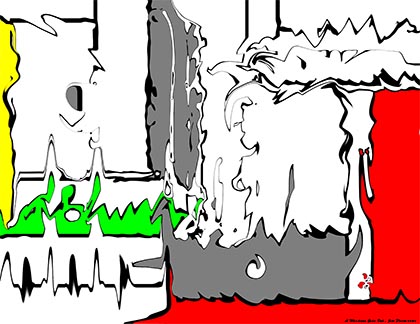How to Prepare Your Art for Galleries Seminar

A Mondrian Gone Bad
Yesterday I attended the seminar How to Prepare Your Art for Galleries presented by Jason Peot. This was one of six seminars for artists sponsored by the Northwest Cultural Council and was held at the Barrington Library. Jason Peot teaches sculpture at Harper College and is curator of the Harper College Art Gallery. I didn't know it but Jason too got his Masters Degree from Northern Illinois University. Go Huskies.
Jason's presentation was not so much about how to prepare your art for galleries but how to get your art out on public display. According to Jason, art galleries are not currently looking for new artists. The economic downturn has been particularly hard on the art galleries and many have closed. Jason confessed that of the Chicago art galleries that have exhibited his work, all are now out of business.
Jason began by stressing that the first question an artist needs to answer is what do you want out of your art? What you want your art to do for you helps determine your path. Answering the question "Do you want your art to be seen or sold?" affects the path you take on getting your art in the public view. Mr. Peot was very big on building your resume by participating in juried competitions and shows. His suggested path was to begin by getting your art into juried shows. The next step is exhibiting in invitational and curated shows. Finally at the top are solo exhibitions.
As a part of his talk, Mr Poet gave a brief slide show of several of the exhibitions he has had over the years. Most impressive was his public commission for a permanent work installed at McCormick Place. Titled Intersect 102, it is a work of installation art that combines light and shadow to represent Illinois' 102 counties.
Jason also shared that these days he is more interested in having his art acquired by museums and that he is actively pursuing that path. In response to my question about how does one go about getting a museum to acquire your art work, Jason said that it is primarily through collectors who have an association with an art museum. He pointed out that much of the work on display in museums has been donated to the museums by collectors as the museums themselves just don't have the budget to be able to purchase art.
The next seminar in the Northwest Cultural Council series will be held January 9 2010 and is How to Write a Winning Resume, Bio and Artists Statement by Deborah Rosen who is a published poet and editor of RHINO, an award winning poetry journal.
The Illustration: A Mondrian Gone Bad
The illustration used for this post is A Mondrian Gone Bad. So how did this picture come about? A couple weeks ago I was in the process of creating 12 pictures in the Neo-Plasticism style of Piet Mondrian. These would serve as illustrations for my Faux Mondrian 2010 calendar for my just created account on Redbubble.com. I had completed 11 and was working on the final image. In fact I had completed the 12th image but then felt the urge to wreck this final image as a form of rejection of the strict formalism of Mondrian's Neo-Plasticism.
An early example of this style is Composition with Red, Blue, Black, Yellow, and Gray which can be seen at the Museum of Modern Art web site – or this example from the Guggenheim:
Composition No. 1; Composition with Red, 1938–39.. While these are typical of Mondrian's best known style of work, I much prefer his earlier output. For example, Church in Domberg painted in 1911.
For more information about Mondrian's Neo-Plasticism, the San Francisco Museum of Modern Art has a nice interactive web feature that explores Mondrian's Composition with Red, Yellow, and Blue.
For a better look at my bad Mondrian, visit my
A Mondrian Gone Bad print on redbubble.com.
| Return to the Blog Index | This entry was posted on Sunday, December 13th, 2009 at 10:47 pm and is filed under Abstract Art, Art and Artists.